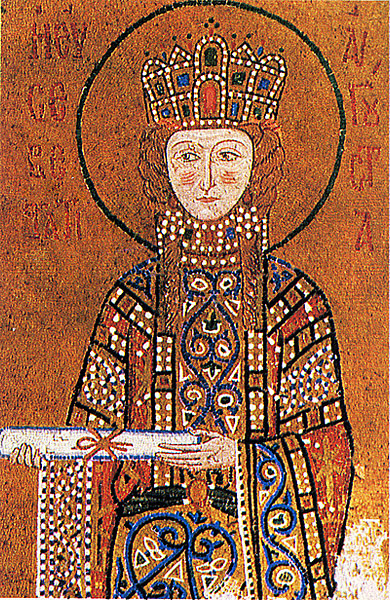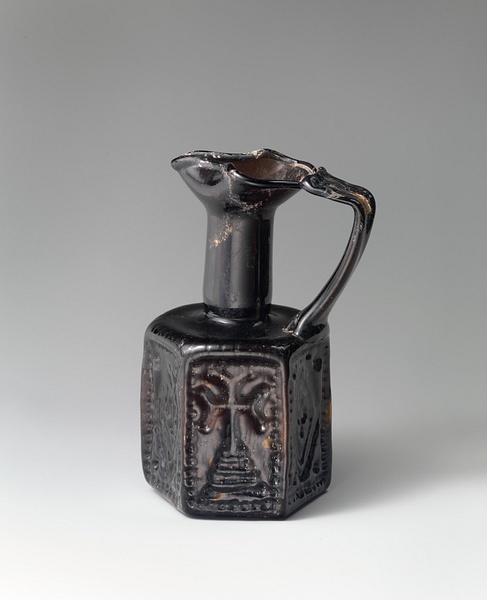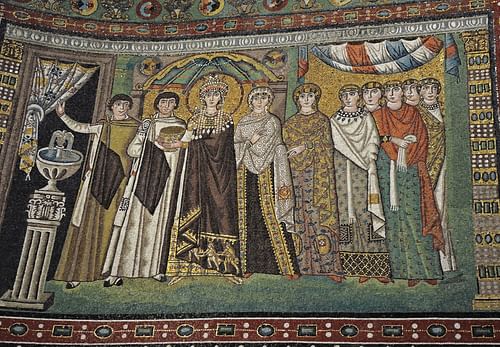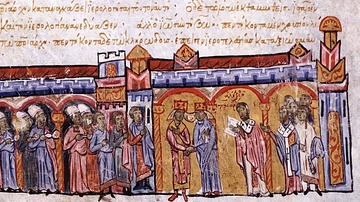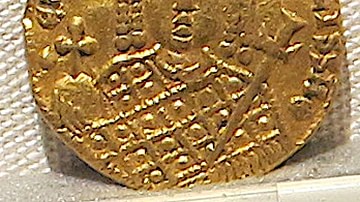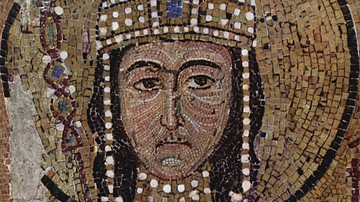Women in the Byzantine Empire (4th to 15th century CE) were, amongst the upper classes, largely expected to supervise the family home and raise children while those who had to work for a living did so in most of the industries of the period, from manufacturing to hospitality. Although they were the minority, some women did manage to rise above the limitations imposed on them by the male-dominated culture and became hugely successful businesswomen, writers, philosophers and even empresses who ruled as regents or in their own right. Such figures include the empresses Theodora, Irene and Zoe, the biographer Anna Komnene, Hypatia the philosopher, and Kassia the poet.
Sources
Unlike in many other medieval cultures, Byzantine history, as written by the people of the period themselves, almost exclusively focuses on the exaggerated deeds and misdemeanours of emperors along with a separate and equally problematic literature on saints and squabbles over religious doctrine. Social history is almost entirely neglected and what remains for modern historians to study is, unfortunately, woefully insufficient to comprehensively reconstruct such features of Byzantine history as class relations, family life and economics. As the historian C. Mango regretfully summarises:
There is little hope that this meagre and haphazard body of material will ever be increased, nor can we remedy the near absence of inscriptions on stone, which for classical antiquity provide such a rich source of information for society, institutions, and religion. (8)
Another difficulty, and a common one for ancient societies, is that sources are almost always written by men writing from their own perspectives and with their own prejudices. Still, we must make the best of what we have and it is possible to make many useful observations on the role of women in Byzantine society by piecing together indirect references, colourful biographies of famous women, sometimes the literary works of women themselves, depictions in art, and so on.
The Role of Aristocratic Women
As in most ancient cultures, the women we know most about in Byzantium are those who belonged to the upper classes. One event which greatly affected the role of all women in Byzantine society, though, was the increasing prominence of Christianity through the centuries, as here summarised by the historian L. Garland:
…options for women evolved throughout the empire while still reflecting both the provisions of Roman law and longstanding customs. Christian values became more widely accepted and, with celibacy and virginity seen as an ideal lifestyle, women increasingly saw a life of chastity as an option. Many girls in the fourth and fifth centuries went into monastic institutions or, more usually, lived celibately at home, while the church instituted an “order” of virgins to support such girls as it did for widows. Marriage was, however, to remain the norm, and the majority of women in Byzantium were expected to concentrate on family duties as wives and mothers. (in Bagnall, 7117)
To better ensure a girl remained a virgin until marriage, some attempt at segregating boys and girls was made with the latter expected to largely remain in the confines of the family home and only come into direct contact with males who were close members of the family. For more well-off families, there was even a segregated part of the home reserved only for the women of the household, the gynaikonitis, but this seems to have been a private space to keep men out rather than a restricted place from which women could not leave. In practice, it is clear that women could and did enter the wider world. Women spent time in public places: among others, shopping in the market squares, attending the public baths, visiting relatives, attending church (where they sat apart from the men), and participating in festivals.
Aristocratic women in the Byzantine Empire, then, like in the earlier Western Roman Empire, were largely expected to marry, produce children and then look after them. Women also cared for the family home - specifically its property and servants. Girls, if they received education at all, were educated in the family home. They were taught spinning and weaving, and they studied the Bible and the lives of the saints. Reading was much more common than the skill of writing and, as the historian J. Herrin points out:
Studies of literacy based on later documents suggest that the ability to read, if not to write, was more widespread among women in Byzantium than in medieval Europe. (122)
The earliest a girl married was around the age of 12 (for boys it was 14). The involvement and consent of the parents was expected and, consequently, a betrothal was usually regarded as binding. Re-marriage was possible as long as a suitable period of mourning was observed by the widow but a third marriage was rare and only permitted under special circumstances which included being without children. Divorce was difficult to achieve, although if a wife committed adultery she could be put aside. Following the reforms of Constantine I (r. 306-337 CE), the only grounds for a woman to divorce her husband was if he was found guilty of murder or witchcraft. The laws of Justinian I (r. 527-565 CE) went even further and prohibited divorce altogether except if both parties consented to retire to a monastic life.

Aristocratic women played an important role in politics and society. They were the medium through which alliances between aristocratic families were made and since they had property of their own, in the form of both dowry and patrimonial property, they had considerable economic power. Names, lineage, property, and family connections were transmitted along the female as well as the male line; and aristocratic women were as acutely conscious and proud of their lineage as their male relatives. (Shepard, 814)
Working Women
Women who had to earn a living worked in the agricultural, retail, manufacturing (especially textiles and silk) and hospitality industries. Some of the known jobs which could be performed by women included those of the weavers, bakers, cooks, innkeepers, washerwomen, midwives, medical practitioners, money-lenders and bath keepers. Many of these jobs and the knowledge connected to them would have been passed down from generation to generation. Some of the more unusual female professions were sorcerers and matchmakers. There was nothing to prevent women from owning their own businesses such as inns and shops.
Illustrating that women could own their own business and do very well indeed is the case of the well-connected aristocrat Anicia Juliana (c. 461 - c. 527 CE), who became perhaps the richest woman in the empire. Anicia did not simply save her fortune but was a celebrated sponsor of church buildings and art, notably building and furnishing the Saint Polyeuktos and Saint Euphemia churches in Constantinople with fine artworks. The former was probably the largest church in the capital until the reconstruction of the Hagia Sophia by Justinian I.
The lowest class of women were the prostitutes and actresses, who were considered to be pretty much the same thing in Byzantine society, at least in the eyes of the upper classes. Brothels were present, especially in the busy ports of the empire such as the capital and Ephesus. Actresses were usually expected to deliver pornographic singing and dancing routines in theatres or public arenas like the Hippodrome of Constantinople - hence their dubious reputation.
There was likely very little movement between classes in Byzantine society but there was one quick route that could be taken from the very bottom to the very top of the social ladder. This was the imperial bride show organised for an emperor to find himself an empress. Naturally, a girl from an important family, even a foreign one, might have had an advantage as she provided a means to strengthen diplomatic relations at home or abroad but a common girl might just get chosen if she were pretty and bright enough. Empress Irene became one such case when she was plucked from the obscurity of a modest Athenian family and chosen to be the wife of Emperor Leo IV (r. 775-780 CE). A less ambitious target for mothers was to send their daughters to the imperial court where they might gain employment as ladies-in-waiting.
Women's Rights
Women had certain rights regarding property. A wife could not be separated from her dowry and daughters could inherit an equal portion of the family estate with their brothers if no specific will was made. If a husband died, his wife became the official guardian of the children. Women could, then, become landowners in their own right, head a household and be subject to taxes like any landowning male.
A woman could not perform any judicial duties or any significant religious function in the Church with the exception of widows over 40 years of age who could act as deaconesses or be involved with services specifically aimed at women such as female baptisms. There were many monasteries devoted to women and at these they held all posts, including that of the abbess. Such nunneries attracted not only those wishing to devote their lives to Christ but also women who had become widows or lacked the means to live independently in the outside world. They were also a place of refuge and help for female victims of crime, illness and general misfortune.
A Byzantine woman may not have enjoyed exactly the same rights and privileges as a male but in one area they were regarded as equal: that of the Christian faith. There was spiritual equality and many of the most revered saints and martyrs were women. Mary Theotokos (the Mother of God) holding the infant Christ was one of the most common images in icons of the Byzantine Church.
Women may not have had much opportunity in the formal church hierarchy but they could make their mark as individual holy persons who inspired others to follow them. Byzantine ascetics achieved celebrity for their great feats of endurance and personal sacrifice in order to be closer to God and a small number of these were women. The most famous is perhaps the 5th-6th century CE Saint Matrona of Perge who, following a vision, cut off her hair, disguised herself as a eunuch and entered a male-only monastery in Constantinople, calling herself Babylas. There she outdid the male monks in her fasting and ascetic lifestyle but, when discovered by the abbot, she was forced to move out to a female monastery in Emesa, Syria. Performing miracles, her reputation grew so that she could return to Constantinople where she established her own famous monastery which included clientele who were members of the imperial family. Her ascetic life did her no harm physically and she lived to the ripe old age of 100.
Famous Byzantine Women
Byzantium has a long history and it involves many women of note. Perhaps the first Byzantine woman to achieve lasting fame is Helena (born c. 250 CE), the mother of Constantine I, who famously embarked on a pilgrimage to Jerusalem where she built several churches, notably the Church of the Nativity at Bethlehem, and gave out money to the worthy and needy. According to legend Helena discovered the True Cross on her travels and brought it back to Constantinople.
Hypatia of Alexandria (c. 370-415 CE) was a celebrated philosopher, scientist and mathematician who also tutored at the famous university of her home city. Hypatia met a violent end for her pagan views: she was stabbed to death with quill pens (or hit with tiles in another version of events) by a group of pro-Christian hospital attendants.
Empress Theodora (r. 527-548 CE), the wife of Justinian I, is perhaps the most famous of all the Byzantine empresses today. Overcoming the stigma of her early career as an actress in the Hippodrome of Constantinople, she would become an invaluable support for her husband, famously convincing him to face and put down the dangerous Nika Revolt of 532 CE. She is also the subject of one of the most celebrated Byzantine artworks, the mosaics of the San Vitale church in Ravenna, Italy. One glittering panel shows Theodora resplendent with a large halo and wearing a great deal of jewellery and a Tyrian purple robe. It is an iconic image of Byzantine womanhood that has coloured how empresses and aristocratic women of the period are viewed ever since it was made.
Irene was the only female Byzantine ruler to assume the male title of basileus or “emperor” (as opposed to empress). The wife of Leo IV (r. 775-780 CE), when he died Irene assumed the role of regent for her son Constantine VI from 780 to 790 CE. From 797 to 802 CE she ruled as emperor in her own right, the first woman to do so in Byzantine history. Her troubled reign, scheming plots to keep her throne and the infamous blinding of her son, have led to her gaining the darkest of reputations - and this is not helped by such conceits as Irene being the only Byzantine ruler to ever put her face on both sides of her gold coins.
Another famous Byzantine woman was Zoe, the daughter of Constantine VIII (r. 1025-1028 CE), who had no sons, and so she became empress in 1028 CE, ruling until 1050 CE with also a brief spell as co-ruler with her sister Theodora in 1042 CE. Zoe had a hand in the succession of five different emperors, three of whom were her husband: Romanos III (r. 1028-1034 CE), Michael IV the Paphlagonian (r. 1034-1041 CE) and Constantine IX (r. 1042-1055 CE). Accused of murdering her first husband, she was banished to a monastery before returning once more to the throne in 1041 CE after her second husband's death. She is the subject of a colourful biography by the 11th century CE Byzantine historian Michael Psellos.

Finally, in this brief summary of only a few of the notable Byzantine women, there is Kassia the poet. Living in the 9th century CE, she was not selected in a bride show for the emperor Theophilos (r. 829-842 CE) despite her great beauty and retired thereafter to a monastery. There she wrote religious poems and the music to accompany them, several of which are still used in Orthodox church services today.
